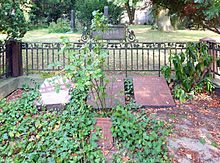Hermann Weigand
Hermann Weigand (* 2. February 1854 in Bydgoszcz ; † 16th October 1926 in Berlin ; Complete name: Hermann Eduard Karl Emil Ferdinand Weigand ) was a German architect and civil engineer and construction officer, Mr . He worked as a town planning officer in Rixdorf, today's Berlin-Neukölln .
Training and works
After studying at the Technical University of Charlottenburg , he passed the second state examination. From 1890 to 1904 Weigand worked as a government master builder ( assessor ) for civil engineering in the public sector; he had his apartment at Sonnenallee 244. From 1904 to 1921 he was the town planner for civil engineering in Rixdorf and Neukölln. Under his direction and planning, over 20 buildings, mainly schools, were built there. At least as important were his plans and the subsequent construction of a sewer system with waste material and fields in Waßmannsdorf and Boddinsfelde in Brusendorf as part of the Hobrecht plan . Finally, Weigand earned merit in the expansion of the Neukölln shipping canal .
His commitment to the administration was recognized by being awarded the title of City Elder in 1924.
His grave in Friedrichswerder Cemetery II on Bergmannstrasse in Berlin-Kreuzberg is a Berlin honorary grave .
The Weigandufer in Berlin-Neukölln, which was given this name on May 2, 1904, during his lifetime, is a reminder of him .
literature
- 100 years of building for Neukölln - a municipal building history. District Office Neukölln of Berlin, Dept. of Construction, Berlin 2005, ISBN 3-00-015848-0 .
Web links
- Hermann Weigand District Office Neukölln
Individual evidence
- ^ Weigand, H. In: New address book for Berlin and its suburbs , 1896, part 5, p. 198, Rixdorf. "Reg.baum."
- ↑ Hermann Weigand in honor directory of Luisenstädtischer Education Association
- ↑ Weigandufer. In: Street name lexicon of the Luisenstädtischer Bildungsverein (near Kaupert )
| personal data | |
|---|---|
| SURNAME | Weigand, Hermann |
| ALTERNATIVE NAMES | Weigand, Hermann Eduard Karl Emil Ferdinand (full name) |
| BRIEF DESCRIPTION | German architect / civil engineer and municipal building officer in Rixdorf / Neukölln |
| DATE OF BIRTH | February 2, 1854 |
| PLACE OF BIRTH | Bromberg |
| DATE OF DEATH | October 16, 1926 |
| Place of death | Berlin |
